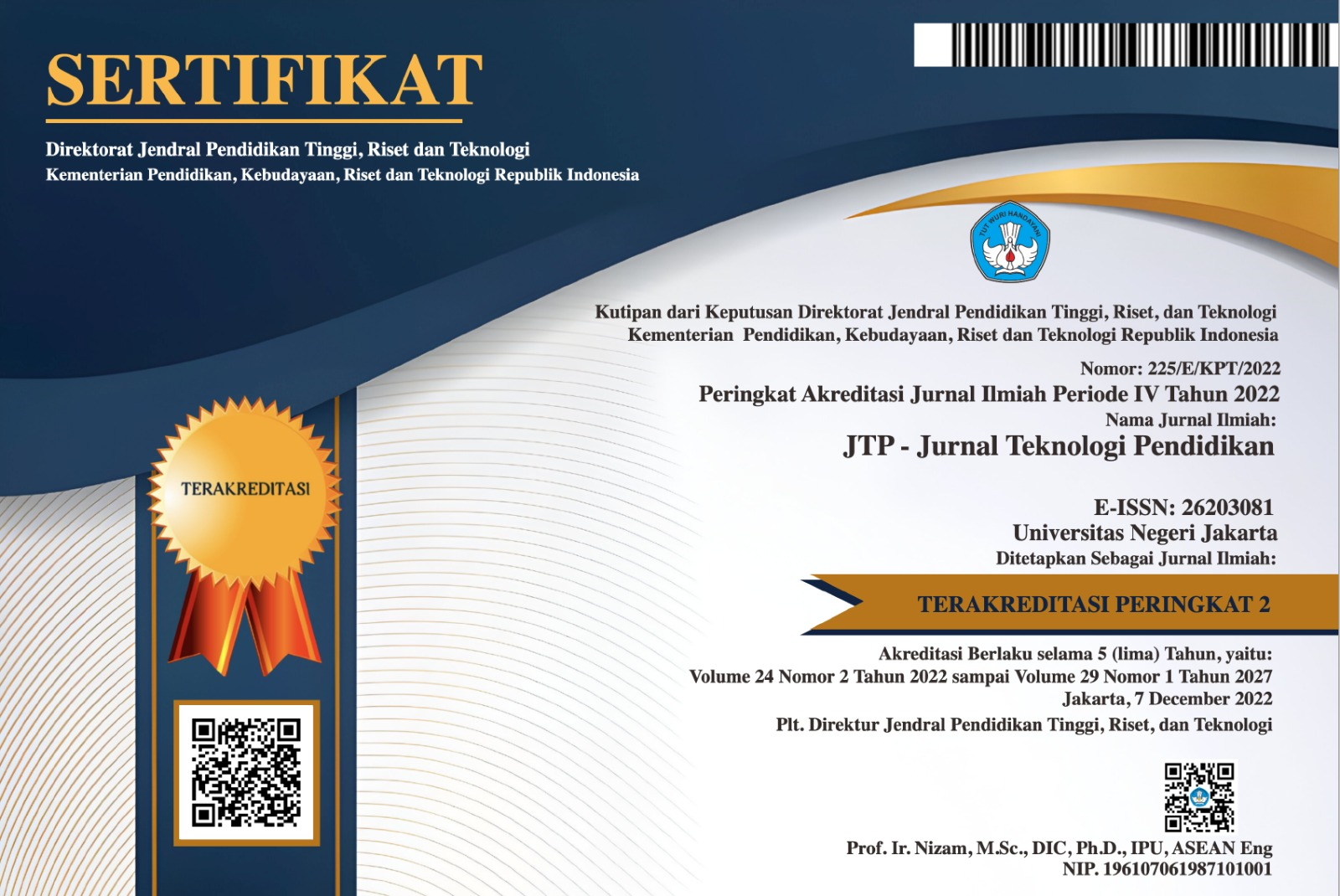Strengthening Pancasila Student Profile Based on Technological Pedagogical and Content Knowledge
DOI:
https://doi.org/10.21009/jtp.v26i3.50339Keywords:
strengthening the profile of Pancasila students, based learning , TPACKAbstract
Learning in elementary schools is currently directed to integrate technology that is aligned with the mission of the material in order to achieve quality results and student character, namely strengthening the profile of Pancasila students. This TPACK construction is expected to form student output as lifelong learners who have global abilities and behavior according to Pancasila values. Field studies need to analyze the integration of technology in learning as an effort to form students who are democratic, capable, and productive Indonesian citizens in the 21st century. The purpose of this study is to fundamentally analyze the model of strengthening the profile of Pancasila students based on TPACK at SDIT Usamah, Tegal City, as well as supporting factors and constraints. This type of research is descriptive qualitative; research location SDIT Usamah, Tegal City; data sources in the form of informants, activities, and documents; Data were collected using non-participant observation techniques, in-depth interviews, documentation studies; data validity testing by extending observations, increasing perseverance in research, discussions, triangulation. Data were analyzed using interactive model techniques flowing through data collection, data reduction, data display and conclusions. The results of the study indicate that strengthening the profile of Pancasila students based on TPACK at SDIT Usamah, Tegal City, especially in grade IV in science learning integrates technology applied through learning media and learning models. The dimensions of the Pancasila student profile are focused on three dimensions that are relevant to the material and objectives of science learning, including: 1) the dimension of global diversity; 2) the dimension of mutual cooperation; 3) the dimension of critical reasoning.
References
Aiman and Ahmad. (2020). Problem-Based Learning (PBL) on Science Literacy of Fifth Grade Elementary School Students. Flobamorata Elementary Education Journal.
Ambarwati, et al. (2020). Literature Study: The Role of Educational Innovation in Digital Technology-Based Learning. Journal of Educational Technology Innovation Volume 8, No. 2 Online:http://journal.uny.ac.id/index.php/jitp.
Antony, dkk (2019). Teacher’s TPACK Profile: The Affect of Teacher Qualification and Teaching Experience. Journal of Physics: Conference Series.
Arifin and Fauzi. (2024). digital divide among students in the era of attention economy; case study at Madrasah Aliyah Al-Ibrohimy Galis. Jurnal Al-Ibrah | Vol. 9 No. 1 June 2024.
Firdausi (2022). The Effectiveness of Canva Media on Indonesian Language Learning Outcomes for Advertising Materials for Class V MI Nurul Ihsan Boyolali in the 2022/2023 Academic Year.
Fuaddah. (2023). Perspective; Utilization of Information and Communication Technology in 21st Century Learning in Junior High Schools. Transformative Education Journal (Jupetra) e-ISSN: 2963-3176. Vol. 02 No. 02 (2023): June 2023.
Hajar, et al. (2023). The Influence of Canva Application-Based Learning Media on the Learning Interests of Fifth Grade Elementary School Students. Journal on Education Volume 06, No. 01, September-December 2023, pp. 6404 – 6413.
Hanik, E. U., Puspitasari, D., Safitri, E., Firdaus, H. R., Pratiwi, M., & Inayah, R. N. (2022). Integrasi Pendekatan tpack (technological, pedagogical, content knowledge) guru sekolah dasar sikl dalam melaksanakan pembelajaran era digital. JEID: Journal of Educational Integration and Development, 2(1), 15 27.
Kurniawaty, I., Faiz, A., & Purwati. (2022). Strategi Penguatan Profil Pelajar Pancasila di Sekolah Dasar. Edukatif: Jurnal Ilmu Pendidikan, 4(4): 5170.
Mawarni, dkk. (2024). Pengembangan Media Pembelajaran Interaktif Canva pada Materi Implementasi Nilai-Nilai Pancasila Jenjang Sekolah Dasar. Jurnal: Basicedu.Volume 8 Nomor 4 Tahun 2024 Halaman 2660 –2671Research & Learning in Elementary Education.
Miles, M.B., & Hubermen, A.M. (2007). Analisis data kualitatif. (Terjemahan Tjetjep Rohindi Rohadi). Jakarta: Universitas Indonesia Press.
Moleong, J. L. (2017). Metodologi Penelitian Kualitatif. Bandung: PT. Remaja Rosdakarya.
Muntamah, et al. (2023). Potential Application of STEAM (Science, Technology, Engineering, Art, Mathematics) Approach in Natural and Social Sciences (IPAS) Project Learning in Vocational High Schools. Journal of Learning Innovation in Schools, 4(1), 77-83.
Sugiyono. (2015). Educational Research Methods: Quantitative, Qualitative, and R&D Approaches. Bandung: Alfabeta.
Sundari. (2024). Learning Transformation in the Digital Era: Integrating Technology in Modern Education. Sindoro Cendekia Pendidikan Journal.https://doi.org/10.9644/sindoro.v4i5.3325.
Downloads
Published
How to Cite
Issue
Section
License
Copyright (c) 2024 Kurotul Aeni, Noening Andrijati, Tri Astuti, Afifah Rosianingrum, Salfaniar Hyda Afkawati

This work is licensed under a Creative Commons Attribution-ShareAlike 4.0 International License.
Jurnal Teknologi Pendidikan is an Open Access Journal. The authors who publish the manuscript in Jurnal Teknologi Pendidikan agree to the following terms.
Attribution-ShareAlike 4.0 International (CC BY-SA 4.0)
-
Attribution — You must give appropriate credit, provide a link to the license, and indicate if changes were made. You may do so in any reasonable manner, but not in any way that suggests the licensor endorses you or your use.
-
ShareAlike — If you remix, transform, or build upon the material, you must distribute your contributions under the same license as the original.
- No additional restrictions — You may not apply legal terms or technological measures that legally restrict others from doing anything the license permits.
Notices:
- You do not have to comply with the license for elements of the material in the public domain or where your use is permitted by an applicable exception or limitation.
- No warranties are given. The license may not give you all of the permissions necessary for your intended use. For example, other rights such as publicity, privacy, or moral rights may limit how you use the material.







